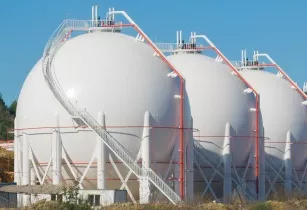As the global energy crisis deepens and countries scramble to secure reliable energy sources, investments in new liquefied natural gas (LNG) infrastructure are set to surge, reaching US$42bn annually in 2024, Rystad Energy research shows
The new LNG projects are driven mainly by a short-term increase in natural gas demand in Europe and Asia. (Image Source: Adobe Stock)
These greenfield investments are 200 times the amount in 2020, when just US$2bn was invested in LNG developments due to the pandemic. Project approvals after 2024, however, are forecast to fall off a cliff as governments accelerate investments in low-carbon energy infrastructure.
The new LNG projects are driven mainly by a short-term increase in natural gas demand in Europe and Asia due to Russia’s war in Ukraine and ensuing sanctions placed on Russian gas exports. Spending on greenfield LNG projects this year and next will stay relatively flat, with US$28bn approved in 2021 and US$27bn in 2022. Investments sanctioned in 2023 will show a modest increase, nearing US$32bn, before peaking at US$42bn in 2024. After this date, investments will decline and drop back near 2020 levels to reach US$2.3bn in 2029. Despite an expected jump in 2030 when project announcements are forecast to total nearly US$20bn, investment in greenfield LNG is unlikely to ever return to 2024 levels as countries scale up investments in low-carbon technologies.
Natural gas is a core component of many countries’ power generation systems and, although there is a determination to reduce fossil fuel dependency and transition to a low-carbon power mix, demand for LNG is set to grow over the short term. The Americas – primarily the US – will account for 30% of cumulative gas demand by 2030, while Asia-Pacific will account for 25%.
With several major LNG projects already underway or in the pipeline, production is predicted to peak at 705 Mtpa in 2034.
“Recent price surges in natural gas markets worldwide have somewhat constrained gas demand, triggering a resurgence of coal-fired power generation in many countries. However, governments remain bullish on gas as an affordable, transition fuel for power in the coming years as demonstrated by the rapid growth in LNG infrastructure investments,” said Palzor Shenga, vice-president of analysis with Rystad Energy.
Where is all this LNG coming from?
The US is set to solidify its place as a top LNG exporter as increased domestic supply and higher prices in Europe and Asia encourage operators to sell gas overseas. The US$10bn Golden Pass LNG project in Texas, a joint venture between QatarEnergy (70%) and ExxonMobil (30%), is expected to start production by 2024, adding export capabilities to the Sabine Pass LNG terminal totalling around 18 Mtpa.
Qatar, already a major producer, aims to boost LNG export capacity to 126 Mtpa by 2027 from a current 77 Mtpa. International industry heavyweights have been chosen to join state-owned QatarEnergy in the North Field East expansion project, which is set to raise capacity to 110 Mtpa.




